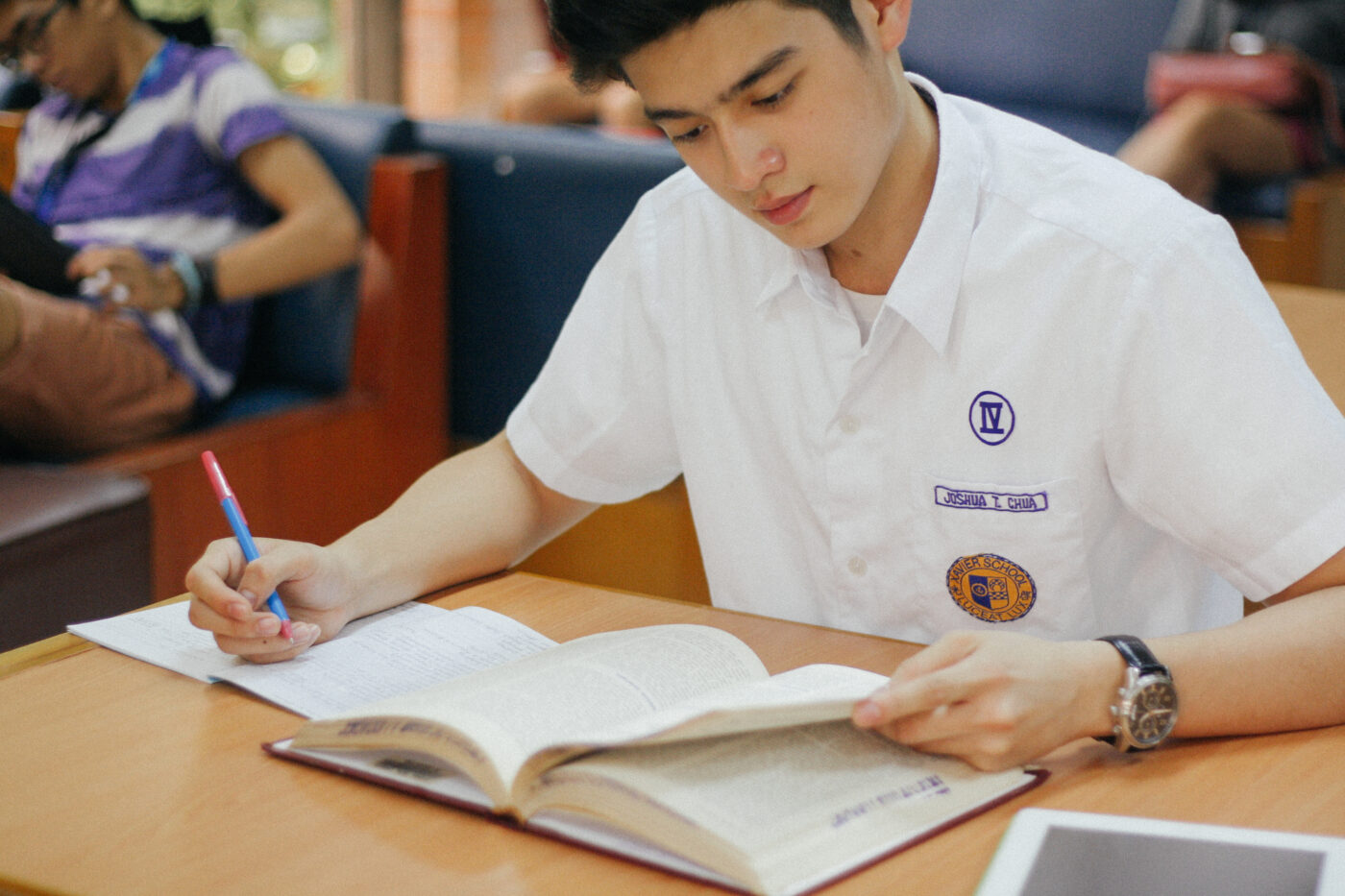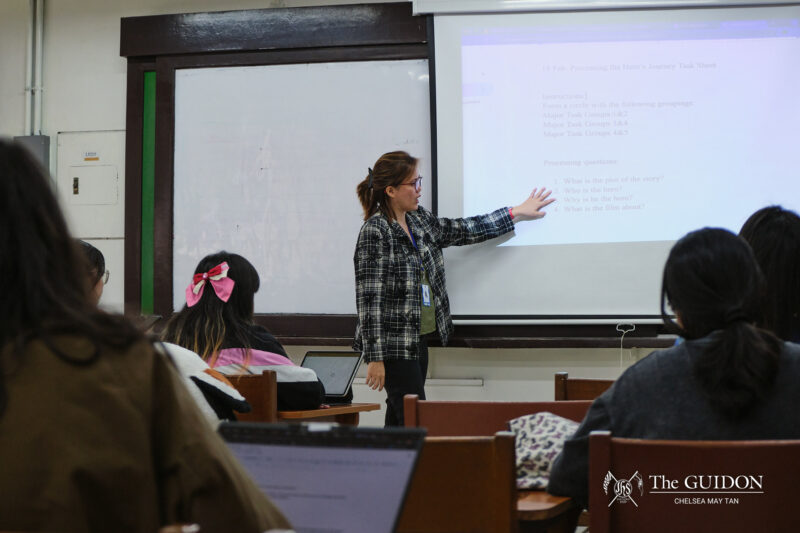Originally, Lorenzo Quigoue was deciding between two different options on how to spend his summer.
Throughout his junior year in high school, he had been looking forward to attending the International Math Olympiad (IMO). It had been his dream to represent the Philippines in this prestigious international math competition, so participating in this event was his top priority. However, he also had a backup plan in case that didn’t pan out—to attend the Ateneo Junior Summer Seminar (AJSS).
In order to get into IMO, he would have to do well in the Philippine Math Olympiad (PMO) first. Unfortunately, he fell ill with a high fever and found himself extremely sick and weak the day before the PMO. “I was completely and utterly exhausted, running on fumes and Tylenols,” he says.
It was with a heavy heart, then, that he took the news that he had failed to qualify for the PMO nationals. “When I found out that I didn’t get in–that’s when I really began to seriously set my sights on AJSS, even though I considered it a second choice. Since I didn’t get into the training pool [for IMO], I would have to settle for AJSS instead,” he says.
For most Ateneans, however, who have never even heard of the program, the question stands—what is the AJSS?
Although AJSS is no secret, the Office of Admissions and Aid (OAA) does not blatantly advertise it. Consequently, AJSS ends up being relatively obscure in the Loyola Schools, to the extent that it is known only by its invitees and their peers.
The elite
“[AJSS]is a one of a kind program in the country facilitated by the [OAA] of the Loyola Schools,” says Kamille Tabalan, the staff member of the OAA who handles this program.
According to Tabalan, AJSS, which has been operating for 47 years now, brings together select high school students from various private, public and parochial high schools from all over the country. These students are given the chance to attend classes in the Loyola Schools free-of-charge during the summer before their last year in high school.
AJSS is an exclusive and highly selective event because only a handful of students are even invited to the program, much less admitted. The Ateneo asks the principals of various high schools across the country to recommend their top five incoming seniors to participate.
The application process for AJSS is similar to the one most undergraduates are familiar with. Each student who decides to apply gets an envelope with an Ateneo application form, an AJSS brochure and other pertinent forms and papers. These elite students then write an essay and take the Ateneo College Entrance Test (ACET) as incoming high school seniors some time in January, along with the transferees, student-athletes and other late exam takers.
“Approximately 70 students are chosen based on their performance in the [ACET], high school grades, recommendation forms and co-curricular and extra-curricular activities,” Tabalan says.
Admissions decisions come out in late February. Some students are offered a place in the waitlist, while many other applicants do not make the cut, despite being top-tier students in their respective high schools. The fact that AJSS regularly turns down future valedictorians and salutatorians—applicants who would almost certainly get accepted into the Ateneo during the regular admissions process—is a testament to how selective this program is.
Successful AJSS applicants also gain the option of taking the ACET a second time during the regular admissions process. “If you were accepted into AJSS, you don’t have to take the entrance test for seniors anymore. Though a lot of us aiming for higher scores still chose to, so we’d have more opportunities to get scholarships,” says Miko Alazas, a political science junior and alumnus of AJSS Batch 44. This course of action poses a risk however, as AJSS applicants who opt to take the ACET a second time essentially waive their first score.
It must be stressed that academic performance is not the sole criterion for gaining admission. “If you’re given the opportunity to apply for AJSS, you probably have high grades. But you need to find something that will make you stand out, something uniquely your own,” Alazas says.
What this “something” is, according to Nenette Zabala, the Assistant to the Director of the OAA, consist in having a “leadership role in extra and co-curricular activities in the school, parish and community” and possessing “a genuine desire to [affect] social change and render service to God, man and country.”
Special activities
According to Alazas, the summer seminar is largely analogous to the experience of most freshmen in the Loyola Schools, albeit compressed into six weeks. “Officially, we spent most of our time in the classroom, 8:00 AM to 3:00 PM. In our classes, we pretty much did what freshmen in Ateneo do,” he says.
“Pretty much [doing] what freshmen in Ateneo do,” in this case, largely consists of taking modified math, English, physical education (PE) and both lecture and laboratory components of natural science classes. “We had to make a play for our English class… [had] PE sessions at the Covered Courts, lunches at Gonzaga and [the Junior Student Enterprise Center], [made] ice cream for Chemistry class,” Alazas says.
However, unlike most first-year students, many AJSS participants also get to take Psychology and Philosophy classes—subjects usually taken by undergraduates in higher school years.
These classes are held simultaneously with the Loyola Schools’ regular summer semester, though AJSS students take classes separately from undergraduates. According to Tabalan, AJSS is designed so that the “esteemed Loyola Schools faculty” handle these classes. This attribute of AJSS, in particular, was made evident to Alazas, who lauded the opportunity to interact with some of the school’s most respected academics. “The professors who taught us were mostly senior professors, so it was a great learning experience,” he says.
Still, taking these classes during AJSS does not prevent its participants from having to take them again once they reach college, if they opt to enroll in the Ateneo. As a result, these students get to take the same classes twice, giving them an advantage over most freshmen, who will only be taking these classes for the first time.
Besides this, AJSS students also take part in a number of other activities that go beyond what many freshmen experience. “There’s so much more to be said about AJSS than the academic side of it,” Alazas says.
These activities include, among others, a sportsfest (which features many of the school’s celebrity athletes, such as Kiefer Ravena and Alyssa Valdez), a night of stargazing in the Manila Observatory for Physics class, a series of camps hosted by different school departments and various group dynamics activities.
However, the most highly anticipated event is AJSS Night, which happens towards the end of the summer program. This is akin to a high school prom, albeit with other AJSS students. What makes AJSS Night particularly memorable is a tradition that Ateneo alumni are very familiar with—the giving of the Blue Rose.
The event was particularly memorable for Quiogue, who ended up doing something he previously would have thought himself incapable of. “AJSS changed me in so many ways, and that’s why I found myself in front of the microphone, making a speech on why I would give the rose to that particular person.”
At the end of six weeks, AJSS students graduate from the program, wherein a class valedictorian and salutatorian are selected and academic distinction awards are given to the top performers in particular subjects.
A more subdued reason
For all the resources the school expends to give 70 or so incoming high school seniors free classes in the Ateneo (complete with dorms for students from the provinces)—in addition to funding a number of extravagant events—it is worth wondering why the college hosts this costly summer seminar in the first place.
“The AJSS aims to introduce the talented and vibrant students to college campus life, particularly college-level courses, professors, facilities and activities. It is a special opportunity for them to have a glimpse of the Ateneo Way,” says Tabalan.
Besides this, she also cites how AJSS allows the Ateneo’s faculty to get to know the top high school students in the Philippines. “The interaction with these young students is a good chance to know things that they like as well as their needs,” she says.
It is widely believed among AJSS participants, however, that there is a more subdued reason as to why the university chooses to hold AJSS. Ultimately, it wants to persuade the best of the best high school students in the country to attend the Ateneo when they graduate.
“They really went out of their way to catch us—in fact, our Ateneo application forms were free and delivered to our high schools,” Quiogue says. Alazas echoes a similar sentiment: “The teachers didn’t really go that hard on us, ‘cause they also wanted us to end up studying there.”
By doing this, the school can recruit the top students in the country to attend the Ateneo, thereby preserving the university’s academic reputation. Moreover, having elite students for classmates will serve to augment classroom discussions and motivate the rest of the student body to push its academic boundaries.
Quiogue, who eventually graduated valedictorian of Ateneo de Manila High School Class of 2013, had initially committed to attend the Loyola Schools for college, largely because of AJSS. However, he ultimately chose to attend Princeton University in the United States, as he found the lure of an Ivy League education to be too tantalizing to pass up.
Alazas, on the other hand, who was ranked second in his graduating class in PAREF Springdale School in Cebu, chose to attend the Ateneo over other elite colleges like the University of the Philippines (UP), in part because of his experiences in AJSS.
“When I was deciding between UP and Ateneo, there were definitely key factors that AJSS brought into the picture,” he says. “By the end of AJSS, you’re already kind of brainwashed into the whole magis, Blue Eagle culture, so most people who actually wanted to go to UP were really torn. Lastly, I also think the program does a great job in making you feel special, as if Ateneo really wants you. I think those are how AJSS unconsciously affected my decision.”
When reminiscing about the end of his AJSS experience, Quiogue is so moved by the memories that he ends up waxing poetic. “I finally left the hall, disappointed that my experience was finally over, yet extremely thankful that I got the chance to do it,” he says.
In the end, AJSS didn’t end up being a bad “second choice” after all. Somewhere in Princeton, there is a student who is glad he spent his summer in the Ateneo.
For Alazas and the many other AJSS graduates who had opted to stay in the LS, the Ateneo experience had just begun.







